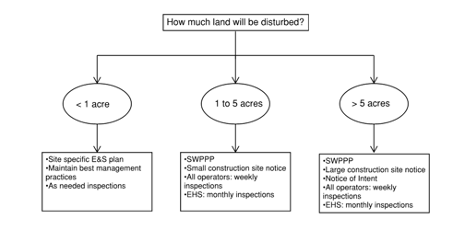For a brief summary of the environmental programs which require project manager’s to contact EHS, please see the Quick Reference Guide (PDF).
Spill Prevention Control and Countermeasures (SPCC)
Oil storage areas and oil containing equipment must be designed with adequate containment. For indoor units, the containment must be able to hold oil from the unit in case of a rupture or leak. For outdoor units, the containment must be able to hold 110% of oil capacity. The additional capacity is to allow for rainfall from a 25-year, 24-hour storm. For more detail, refer to the SPCC Program
Pre-Treatment Devices
Pre-treatment devices may be required as part of the University’s wastewater permit or by design criteria. Devices must meet certain criteria and be approved prior to installation. For detailed design requirements on all pre-treatment devices,, see Pre-Treatment Device Approval.
Storm Water Pollution Prevention Plans (SWPPP)
All construction projects are required to manage site stormwater runoff. The total acres of disturbed land, including construction support activities, determines whether coverage is required under the TCEQ Construction General Permit (PDF) or if an Erosion and Sedimentation Control (E&SC) plan is acceptable. If greater than an acre will be disturbed, then permit coverage is required. For more information on SWPPP reviews, approvals, and requirements during construction, please see Environmental Requirements - . For more information on SWPPP requirements during construction, please see Environmental Requirements - Construction Phase. Failure to comply with the permit requirements can result in project delays, civil penalties, and/or notices of violation.

Review Process
If there is any outdoor disturbance < 1 acre, including material staging areas, submit a site specific erosion and sediment (E&S) control plan to EHS for review during the design phase. If the total outdoor disturbance is > 1 acre, follow the format outlined in EHS’ SWPPP template (PDF). Submit to EHS for review during the design phase. Allow two weeks for initial comments, and more time for additional review if required changes are extensive. Provide EHS with a final version of the SWPPP, either digital or paper copy, once it has been approved.
Be sure to submit a Notification of Construction Activities (PDF) form at the beginning of the project.
Training
To request a training or submit feedback, please reach out to us by calling (512) 471-3511 or send an email to EHS-EnvironmentalOps@austin.utexas.edu. For additional training resources, please visit Environmental Programs Training.
UT Austin SWPPP Procedures (PDF) Site specific E&S plan Maintain best management practices As needed inspections
Standard for Storm Water Management Design
All new construction or redevelopment that adds greater than 4,000 square feet of impervious cover must adhere to the UT Austin Design Standard for Storm Water Management (PDF). This standard was developed to meet the requirements of the UT Austin Phase I Municipal Storm Sewer System (MS4) Permit, issued by the TCEQ and to comply with the University’s Stormwater Management Program (SWMP). Visit the Stormwater page for more information on the MS4 permit and the University's SWMP.
Green Infrastructure
UT Austin supports the utilization of green infrastructure to manage storm water runoff in lieu of or in combination with more traditional gray infrastructure wherever feasible. Single-purpose gray stormwater infrastructure is largely designed to transport storm water away from buildings as quickly as possible. Green infrastructure both reduces and treats stormwater at its source, contributing to improved water quality, reduced flooding risks, decreased erosion, and increased community satisfaction. Green infrastructure is also often more cost-effective in the long run when factoring in construction and maintenance costs.
Temporary Erosion and Sedimentation Controls
